Object and Class
Class and object are fundamental concepts in object-oriented programming (OOP).
A class is a blueprint or a template for creating objects. It defines the properties and behaviors that objects created from the class will have. For example, a “Person” class might have properties like “name,” “age,” and “address” and behaviors like “walk,” “talk,” and “eat.”
An object is an instance of a class. It is a specific realization of the class with its own values for the properties defined by the class. For example, you could create an object “John” from the “Person” class, with his name as “John,” age as 30, and address as “123 Main St.”
Classes and objects allow you to model real-world concepts in code and encapsulate data and behavior into self-contained entities.
Object Oriented Programming Basics
Object-Oriented Programming (OOP) is a programming paradigm based on the concept of “objects”, which can contain data and code that manipulates the data. OOP focuses on objects, instead of just functions and procedures, and combines data and functions into a single entity. Some key principles of OOP are:
- Abstraction: Hiding complexity by only exposing essential features to the users.
- Encapsulation: Wrapping data and functions within an object to protect it from outside access and modification.
- Inheritance: Allowing objects to inherit properties and behaviors from parent objects.
- Polymorphism: Providing a single interface to objects with different underlying forms.
Some popular programming languages that support OOP are: Java, Python, Ruby, C++, and C#.
OOP Benefits in Software
Object-oriented programming (OOP) is important because it provides a way to structure code and manage complexity in software development by encapsulating data and behavior within objects. OOP offers several benefits including:
- Abstraction: Hides implementation details and exposes only relevant information to the user, making code more maintainable and reusable.
- Encapsulation: Ensures that data and behavior are packaged together within an object, making it easier to manage and protect data.
- Inheritance: Allows code reuse and helps to build new objects based on existing ones, reducing duplication and improving organization.
- Polymorphism: Allows objects to be treated as objects of their base class, even though they may belong to a derived class, improving code flexibility and scalability.
Overall, OOP helps to create a modular and organized codebase, making it easier to understand, maintain, and extend over time.

Pingback: Learn OOP easily | Sanjoy Dey Reju
Pingback: Learn OOP easily | Sanjoy Dey Reju